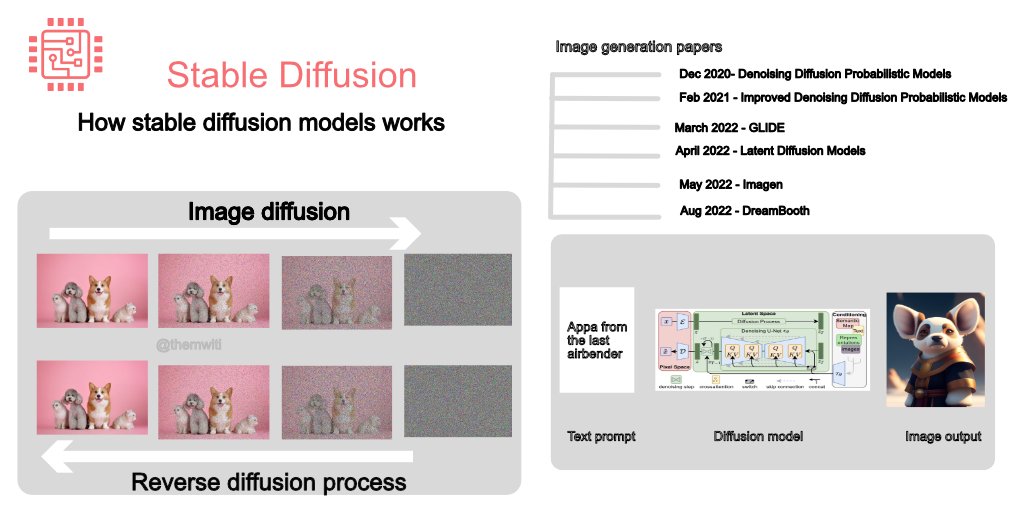Thread
Image generation models are causing a sensation worldwide, particularly the powerful Stable Diffusion technique 🔥.
With Stable Diffusion, you can generate images with your laptop, previously impossible 🤩.
Here's how diffusion models work, in plain English:
-A Thread--
🧵
With Stable Diffusion, you can generate images with your laptop, previously impossible 🤩.
Here's how diffusion models work, in plain English:
-A Thread--
🧵
1/ Generating images involves two processes.
Diffusion adds noise gradually to the image until its unrecognizable, and a reversion diffusion process removes the noise.
The models then try to generate new images from the noise image.
Diffusion adds noise gradually to the image until its unrecognizable, and a reversion diffusion process removes the noise.
The models then try to generate new images from the noise image.
2/ Denoising is done using convolutional neural networks such as U-NET.
A U-NET is made up of an encoder for creating the latent representation of the image and a decoder for creating an image from the low-level image representation.
A U-NET is made up of an encoder for creating the latent representation of the image and a decoder for creating an image from the low-level image representation.
3/ Noise is not removed from the image at once but is done gradually for the defined number of steps.
Removing noise step-by-step makes the process of generating images from pure noise easier.
Therefore, the goal is to improve upon the previous step.
Removing noise step-by-step makes the process of generating images from pure noise easier.
Therefore, the goal is to improve upon the previous step.
4/ Generating the image in one step leads to a noisy image.
At each time step, a fraction of the noise and not the entire noise is removed.
The same concept is used in text-to-image generation, where you inject the textual information gradually instead of at once.
At each time step, a fraction of the noise and not the entire noise is removed.
The same concept is used in text-to-image generation, where you inject the textual information gradually instead of at once.
5/ The text information is added by concatenating the text representation from a language model on the image input and also through cross-attention.
Cross-attention enables the CNN attention layers to attend to the text tokens.
Cross-attention enables the CNN attention layers to attend to the text tokens.
6/ Diffusion models are compute-intensive because of the number of steps involved in the denoising process.
This can be solved by training the network with small images and adding a network to upsample the result to larger images.
This can be solved by training the network with small images and adding a network to upsample the result to larger images.
7/ Latent diffusion models (LDM) solve this problem by generating the image in the latent space instead of the image space.
LDMs create a low-dimensional image representation by passing it through an encoder network. Apply noise to the image representation instead of the image.
LDMs create a low-dimensional image representation by passing it through an encoder network. Apply noise to the image representation instead of the image.
8/ The reverse diffusion process works with the low-dimensional image representation instead of the image itself.
This is a less compute-intensive process because the model is not working with the entire image. As a result, you can perform image generation on your laptop.
This is a less compute-intensive process because the model is not working with the entire image. As a result, you can perform image generation on your laptop.
9/9 You can try out stable diffusion models on:
• @huggingface
huggingface.co/spaces/stabilityai/stable-diffusion with Stable Diffusion 2.1
• lexica.art
• dreamstudio.ai
That's it for today. Follow @themwiti for more posts on machine learning and deep learning.
• @huggingface
huggingface.co/spaces/stabilityai/stable-diffusion with Stable Diffusion 2.1
• lexica.art
• dreamstudio.ai
That's it for today. Follow @themwiti for more posts on machine learning and deep learning.
Follow @themwiti for more content on machine learning and deep learning.
Mentions
See All
Akshay 🚀 @akshay_pachaar
·
Mar 14, 2023
Well written thread !!
Jaydeep Karale @_jaydeepkarale
·
Mar 14, 2023
Superb explanation
